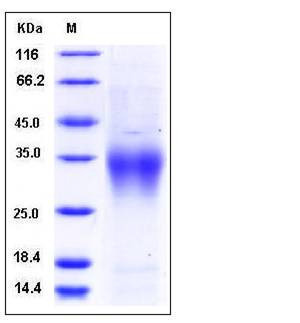Mouse CD28 Protein (His Tag)
Cd28, CH29-189K17.3
- 100ug (NPP1137) Please inquiry
| Catalog Number | P50103-M08H |
|---|---|
| Organism Species | Mouse |
| Host | Human Cells |
| Synonyms | Cd28, CH29-189K17.3 |
| Molecular Weight | The secreted mature form of mouse CD28 consists of 141 amino acids and has a predicted molecular mass of 16.5 kDa. Due to glycosylation, the apparent molecular mass of rmCD28 is approximately 32-35 kDa in SDS-PAGE under reducing conditions. |
| predicted N | Cys 27 |
| SDS-PAGE |  |
| Purity | > 95 % as determined by SDS-PAGE |
| Protein Construction | A DNA sequence encoding the extracellular domain (Met 1-Lys 149) of mouse CD28 (NP_031668.3) was fused with a polyhistidine tag at the C-terminus. |
| Bio-activity | |
| Research Area | Immunology |Adaptive Immunity |T Cell |T Cell CD Antigen |
| Formulation | Lyophilized from sterile PBS, pH 7.4 1. Normally 5 % - 8 % trehalose, mannitol and 0.01% Tween80 are added as protectants before lyophilization. Specific concentrations are included in the hardcopy of COA. |
| Background | CD28 (Cluster of Differentiation 28) is a disulphide-bonded glycoprotein belonging to the immunoglobulin (Ig) superfamily, and structurally consists of a single Ig V-like extracellular domain, a transmembrane domain and an intracellular domain. Mouse CD28 is constitutively expressed on the surface of all murine T cells and on developing thymocytes as disulfide-linked homodimers or as monomers. CD28 can binds the B7-1 and B7-2 ligand, and together perform important functions in the T and B cell response pathways. B7/CD28 family members, which can augment or antagonize T-cell receptor signaling, in the regulation of central and peripheral T-cell tolerance. CD28 is thus involved in T-cell activation, the induction of cell proliferation and cytokine production and promotion of T-cell survival. |
| Reference |
